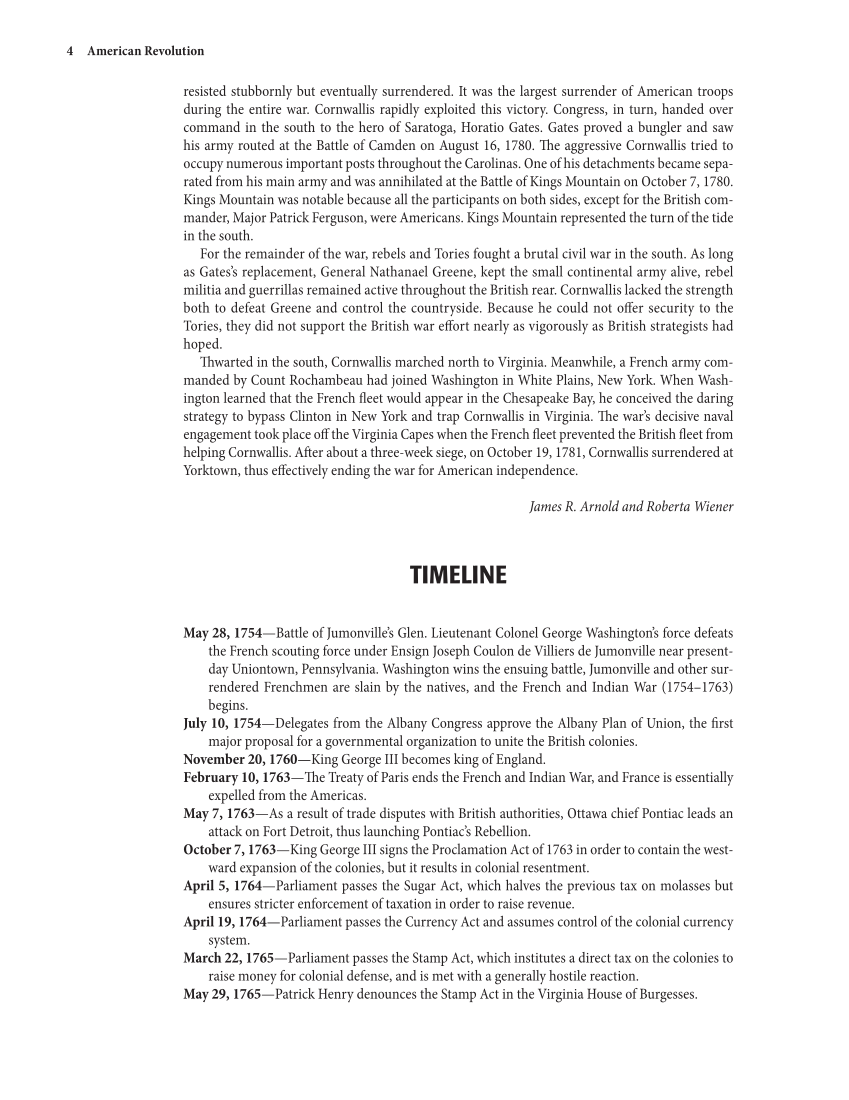4 American Revolution resisted stubbornly but eventually surrendered. It was the largest surrender of American troops during the entire war. Cornwallis rapidly exploited this victory. Congress, in turn, handed over command in the south to the hero of Saratoga, Horatio Gates. Gates proved a bungler and saw his army routed at the Battle of Camden on August 16, 1780. The aggressive Cornwallis tried to occupy numerous important posts throughout the Carolinas. One of his detachments became sepa- rated from his main army and was annihilated at the Battle of Kings Mountain on October 7, 1780. Kings Mountain was notable because all the participants on both sides, except for the British com- mander, Major Patrick Ferguson, were Americans. Kings Mountain represented the turn of the tide in the south. For the remainder of the war, rebels and Tories fought a brutal civil war in the south. As long as Gates’s replacement, General Nathanael Greene, kept the small continental army alive, rebel militia and guerrillas remained active throughout the British rear. Cornwallis lacked the strength both to defeat Greene and control the countryside. Because he could not offer security to the Tories, they did not support the British war effort nearly as vigorously as British strategists had hoped. Thwarted in the south, Cornwallis marched north to Virginia. Meanwhile, a French army com- manded by Count Rochambeau had joined Washington in White Plains, New York. When Wash- ington learned that the French fleet would appear in the Chesapeake Bay, he conceived the daring strategy to bypass Clinton in New York and trap Cornwallis in Virginia. The war’s decisive naval engagement took place off the Virginia Capes when the French fleet prevented the British fleet from helping Cornwallis. After about a three-week siege, on October 19, 1781, Cornwallis surrendered at Yorktown, thus effectively ending the war for American independence. James R. Arnold and Roberta Wiener TIMELINE May 28, 1754—Battle of Jumonville’s Glen. Lieutenant Colonel George Washington’s force defeats the French scouting force under Ensign Joseph Coulon de Villiers de Jumonville near present- day Uniontown, Pennsylvania. Washington wins the ensuing battle, Jumonville and other sur- rendered Frenchmen are slain by the natives, and the French and Indian War (1754–1763) begins. July 10, 1754—Delegates from the Albany Congress approve the Albany Plan of Union, the first major proposal for a governmental organization to unite the British colonies. November 20, 1760—King George III becomes king of England. February 10, 1763—The Treaty of Paris ends the French and Indian War, and France is essentially expelled from the Americas. May 7, 1763—As a result of trade disputes with British authorities, Ottawa chief Pontiac leads an attack on Fort Detroit, thus launching Pontiac’s Rebellion. October 7, 1763—King George III signs the Proclamation Act of 1763 in order to contain the west- ward expansion of the colonies, but it results in colonial resentment. April 5, 1764—Parliament passes the Sugar Act, which halves the previous tax on molasses but ensures stricter enforcement of taxation in order to raise revenue. April 19, 1764—Parliament passes the Currency Act and assumes control of the colonial currency system. March 22, 1765—Parliament passes the Stamp Act, which institutes a direct tax on the colonies to raise money for colonial defense, and is met with a generally hostile reaction. May 29, 1765—Patrick Henry denounces the Stamp Act in the Virginia House of Burgesses.
Document Details My Account Print multiple pages
Print
You have printed 0 times in the last 24 hours.
Your print count will reset on at .
You may print 0 more time(s) before then.
You may print a maximum of 0 pages at a time.
































































































































































































































































































































































































































































































































































































































































































































































































































































































































































































































































































































































